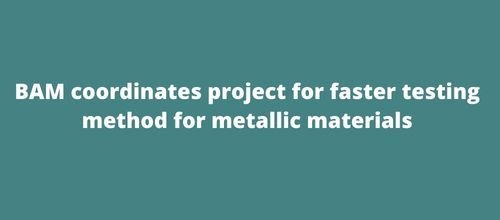BAM coordinates project for faster testing method for metallic materials

The Bundesanstalt für Materialforschung und -prüfung (BAM) is coordinating a project to develop a much faster testing method and accelerate the development of a hydrogen economy.
The project is part of the hydrogen flagship project TransHyDE, which is funded by the Federal Ministry of Education and Research (BMBF).
In future, several million tons of hydrogen will have to be imported to Germany or produced locally every year. In order to enable transport, storage and usage, in these scales, existing natural gas pipelines must be upgraded or converted and new infrastructures must be built. This includes pipelines, high-pressure tanks and distribution stations.
In this sense, metallic materials are in the focus of attention. These Materials can withstand the high pressure under which hydrogen is stored and transported. Before being used for this purpose, it is important to test whether they are suitable for safe use in future hydrogen economy.
Such tests are carried out almost worldwide according to standards of the International Organization for Standardization (ISO). So far, however, the existing ISO standards for the qualification of metallic materials for hydrogen describe complex and costly procedures which thus performed only by very few testing laboratories worldwide.
The consequents of complicated testing procedures and limited laboratory capacities are hindrance of the rapid development of a hydrogen infrastructure. For this reason, ISO has already called for the standardization of a cost-effective and fast procedure for conducting tensile tests on metallic materials in high-pressure hydrogen in August 2021. In these tests, the impact of hydrogen on the properties of the materials in a hydrogen environment and under mechanical load is determined.
For this purpose, BAM has already further developed a method with a so-called hollow tensile specimen technique in its hydrogen competence centre H2Safety@BAM in 2022: Compared to previous methods, this method has the advantage, among other things, that much smaller quantities of hydrogen are required. Therefore, it can be carried out with significantly less effort.
“As part of the TransHyDE project Norm, we now want to further develop this technique with our H2HohlZug project so that it can be standardized by ISO and widely used by testing laboratories,” says Oded Sobol from BAM’s Hydrogen Competence Centre. “To this end, the findings are fed directly into ongoing ISO standardization processes. Our aim is that in future companies in Germany and worldwide will be able to test the H2-readiness of metallic materials much more quickly and easily than before.”
Three major hydrogen lead projects of the BMBF aim to implement the National Hydrogen Strategy. TransHyDE is one of them and is dedicated in particular to the development of an infrastructure for the transport of hydrogen.
